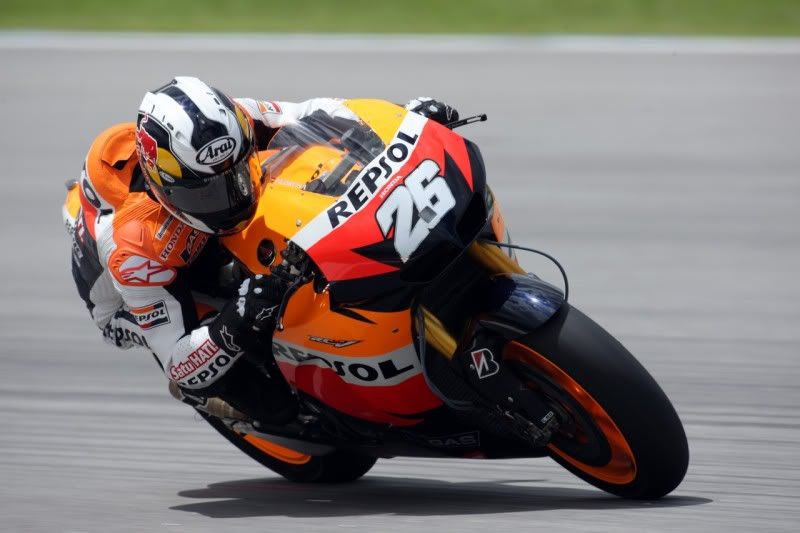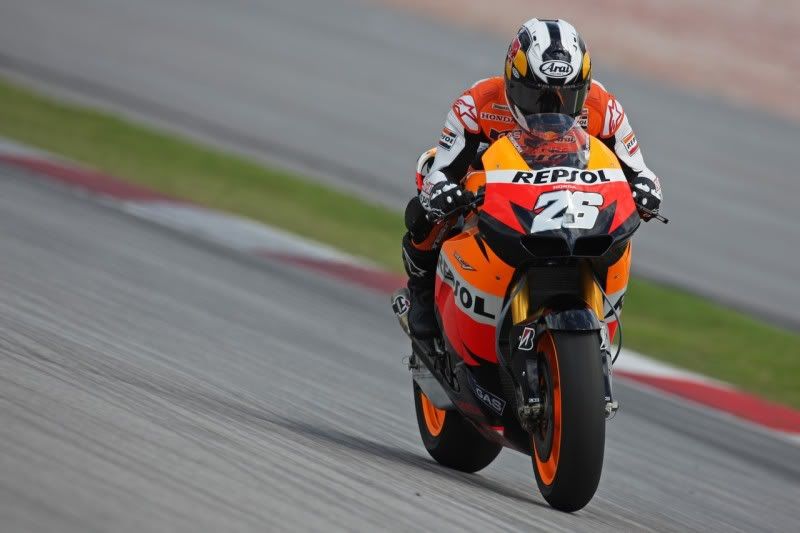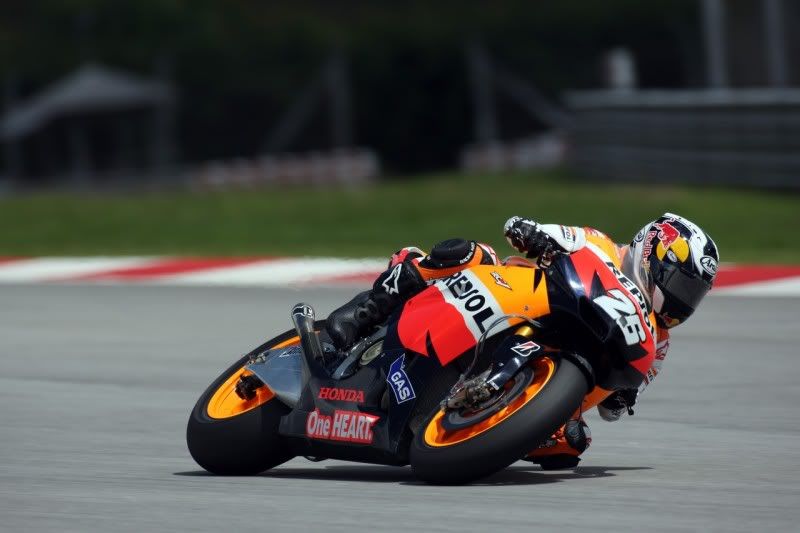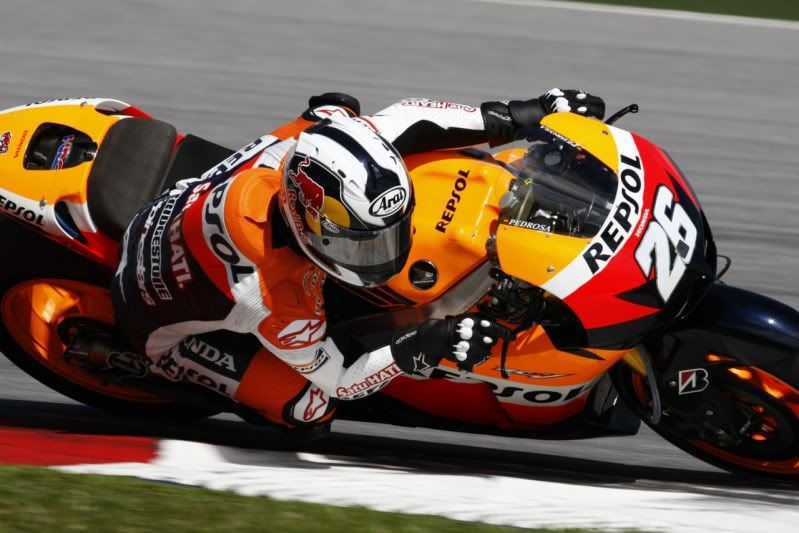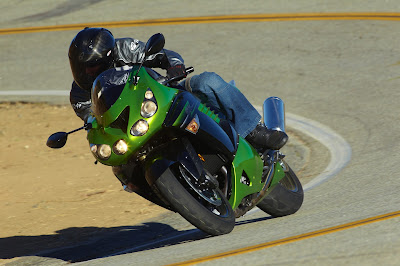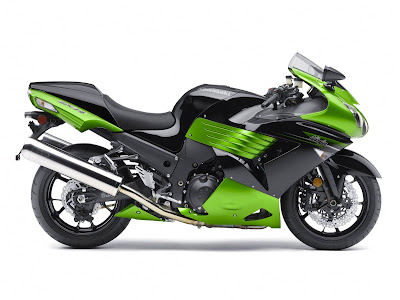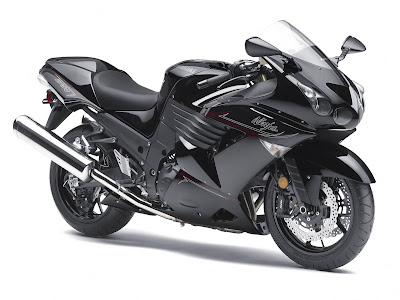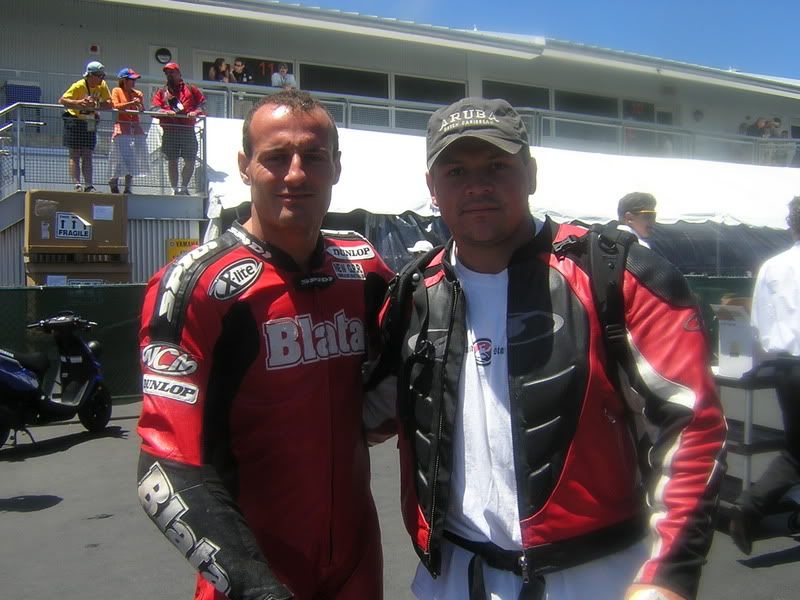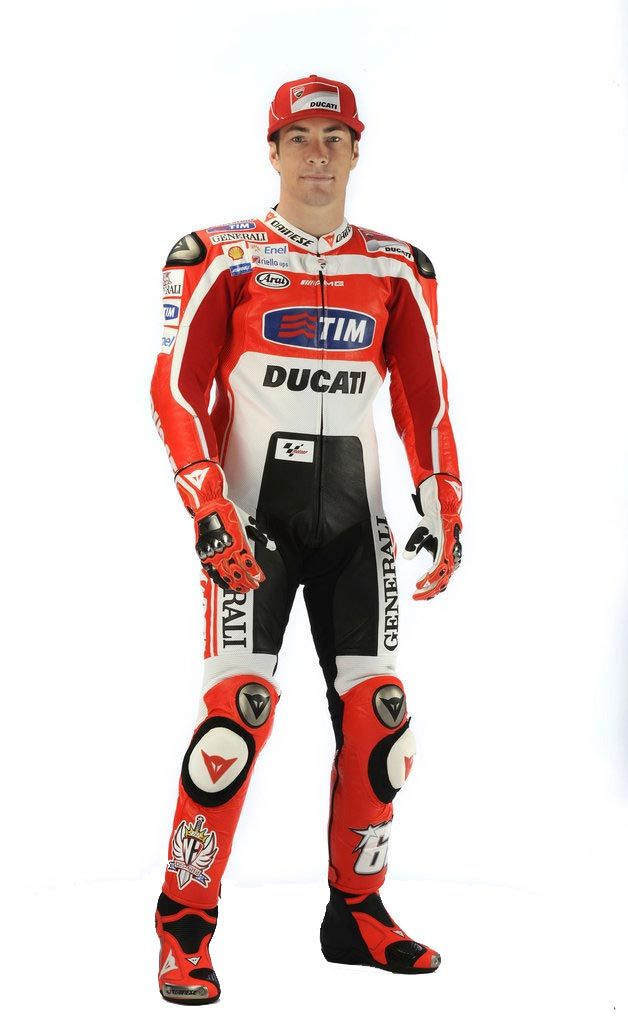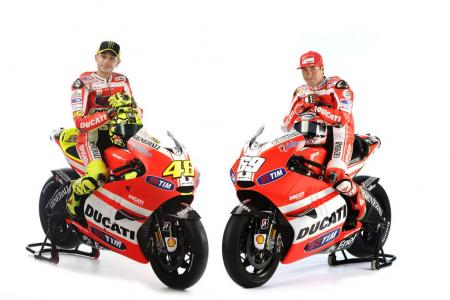Top MotoGp History All of Time
Top MotoGp History All of Time - Motor Racing Championship has been known since 1900. At that time managed by FICM (Federation Internationale des Clubs Motocyclistes) referred to as his great-grandfather FIM today. In Europe dominant race conducted due to technological developments, especially the motor has not so global in those days. FICM formed in 1938 announced a in eruope motor racing championship. But the plan did not go smoothly due to collide with the outbreak of world war two. After the war the new motor racing championship back to life, slowly but surely the competition has started venturing into the international level. MotoGP Championship finally held officially in 1949, divided by four major classes namely class 500cc, 350cc, 250cc and 125cc.
Logged MotoGP world champion title was first won by Leslie Graham joined the team AJS Porcupine (500cc), Freddie Frith on a Velocette Team (350cc), Bruno Ruffo on Moto Guzzi Team (250cc) and Nello Pagani at the Mondial team (125cc). Italian manufacturing decade, Mondial and Moto Guzzi and MV Agusta Gilera together dominate the MotoGP race. The peak is about the 1950 MV Agusta thorough wipe them four different classes in three consecutive seasons (1958-1960). And for 17 years of dominance in the 500cc was never solved as the manufacturer who can win the king's class on an ongoing basis since 1958 to 1974 until the crown was slowly eaten away by the Japanese manufacturers began to exist after World War II. Japanese motors started booming in 1960. Through the three brands at the time Honda, Suzuki and Yamaha manufacturer terrorized Italy in all 125cc, 250cc and 500cc (1960). For the rider, comes the end of 1960 a fairly prominent name who achievements of Giacomo Agostini. 1960 was a historic year for Giacomo Agostini. That year he began to carve his name in the history of MotoGP. Giacomo Agostini the most successful rider of all time (only Valentino Rossi close to his record). Golden age when she rode the MV-Agusta (1968). Because of the high cost of forcing Japanese manufacturers to withdraw join the Yamaha MotoGP and just left at that time. Until the early 1970s they re-joined the new. At that period the world title contested by European manufacturers (Bultaco, Kreidler, Morbidelli, and MV Agusta) American (Harley Davidson) and Japan (Yamaha, Honda, Kawasaki). The dominance of MV Agusta has been little disturbed by motors from Japan. After nearly 12thn break back arena Honda MotoGP (mid 1970) and in around 1983 they changed the philosophy of the engine switch engine 4 stroke 2 stroke (V3 500) is more famous for NS500. Honda NS500 successfully deliver a world champion for the first time through the joint motogp rider Freddie Spencer. Year 1980-1990 was the year in which Japanese manufacturers are very dominating. In the years that the quality of motor racing entered the stage of modern technology with the level of competition is very tight. The battle between the brands of Honda, Honda and Suzuki produced a classic duel-duel is very interesting. Logged Eddie Lawson, Randy Mamola, Freddie Spencer, Wayne Rainey and Kevin Schwantz is a brilliant rider-rider at that time. Generation of 500cc and above in 1990 was dominated by Michael Dohan with NSR 500. Doohan managed to carve a record five-time world champion until injuries forced him to retire early from the MotoGP scene (1999).

After the echoes of the Italian rider to fade after Agostini in 1997 appears Valentino Rossi. Rossi is world champion rider 500cc 2 stroke in serie cover before it was changed to 4 stroke 990cc engine. On his journey level 990cc engine is too tight so that the FIM issuing new regulations to slash levels of speed with the goal of safety (based on the experience of death Daijaro Kato on April 2003). So effectively the 2007 MotoGP machine to downgrade again to 800cc done up to now. Analysis of FIM officials were wrong, because the 800cc machines were not more quietly than 990 machines (technological advances), especially in the strong devour the corner so that the discourse is being deliberated for the return of premium grade motor race racing back to 990cc in 2012.
HistoryWorld Championship for motorcycle racing was first organized by the Fédération Internationale de Motocyclisme (FIM), in 1949. At that traditionally have been held several races at each event for different classes of motors, based on engine capacity, and classes for sidecars (motorcycles bersespan). The classes that exist today it is 50 cc, 125 cc, 250 cc, 350 cc and 500 cc motor for single seater and 350 cc and 500 cc for motorcycle sidecars. Entering the 1950's and throughout the 1960s, 4-stroke engine motorcycles dominate the entire class. In the late 1960s, the motorcycle-engined 2 not begin to master the small classes. In the 1970's 2-stroke motorcycle engine really get rid of 4 stroke engines. In 1979, Honda tried to restore the 4 stroke engines in the top class by lowering the motor NR500, but this project failed, and in 1983, even Honda was winning with 500 cc 2 stroke motor hers. In 1983, 350 cc class finally abolished. 50 cc class was replaced by 80 cc class in 1984, but the classes are often dominated by riders from Spain and Italy was finally abolished in 1990. Class sidecars are also excluded from the world championships in the 1990's, leaving the class 125 cc, 250 cc and 500 cc classes.
GP 500, the premier class of Grand Prix motor racing, has changed dramatically in 2002. From the mid-1970s until 2001 the top class of GP racing this limited 4-cylinder and 500 cc engine capacity, both types of engines 4 stroke or 2 stroke. As a result, are able to survive the 2-stroke engines, which incidentally produces power and greater acceleration. In 2002 to 2006 for the first time allowed manufacturers to increase the total capacity of special machines for a maximum of 4 stroke engine 990 cc, 800 cc and turned into the 2007 season. Manufacturers are also given the freedom to choose the number of cylinders that are used between three to six with a certain weight limit. With the permissibility of motor cc 4 stroke air-large, the GP 500 class renamed to MotoGP. After 2003 no more 2-stroke engine that fell in the MotoGP class. For the class 125 cc and 250 cc in particular still use 2-stroke engine.

Race for the MotoGP class is currently held as many as 17 series in 15 different countries (Spain held a 3 race series). Regular races held every weekend by some stage. Friday free practice and held the first official workout, then on Saturday performed the second official practice and QTT, in which riders try to make the record the best time to determine their starting position. Own race was held on Sunday, although there was a series that was held Saturday in the Netherlands and Qatar. Grid (row starting position) consists of 3 riders per line and usually every racing series, followed by about 20 racers. Racing held for about 45 minutes and the driver raced along the specified number of rounds, without entering the pits to change tires or refuel. Racing will be repeated in case of a fatal accident in the early races. The composition of the grid is not changed according to qualifying results. Racers may enter the pit, if only to replace the motor because of rain during the race.
Organizations in the MotoGPMotoGP racing success is inseparable from the organizations involved in it Several organizations joined in the commission, among others, the FIM Grand Prix, Dorna, IRTA and MSMA.
FIM (Federation Internationale de Motocyclisme) is the highest body in the world to take care of things around the motorcycle. FIM standing in 1904 will not only deal with motor racing, but also became superintendent of production motorcycles are sold en masse, particularly about the safety and feasibility. In motor racing events, FIM is the agency in charge of and responsible about the regulatory and technical aspects of the race, also on the status, extent, and the criteria of a motor racing championship.
Dorna is MotoGP race organizers organization, or in other words is the promoter Dorna MotoGP championship. Dorna is responsible for the quality of the event and also take care of event sponsors.
IRTA (International Road Racing Team Association), a member of this organization consists of teams who follow the MotoGP race. This organization serves to channel the aspirations of the team and the drivers are incorporated in it. With this organization the drivers can provide input and determine the rights and interests, including contract value, safety and feasibility of the circuit.
MSMA (Motorcycle Sport Manufacturer Association) is an organization composed in MotoGP from the motor manufacturers who follow the MotoGP championship, such as Honda, Yamaha, Ducati, Suzuki, Kawasaki, and other manufacturers. The function of this organization, among others, to decide the technical rules regarding the regulation of motor along with other organizations who joined the commission Grand Prix.
Career DriversThere is a hierarchy career for riders who fall in the motor racing world, when a pretty accomplished rider he will be recruited by a team there next class of the class 125 cc, 250 cc class, then the top class of MotoGP. Drivers who fall in the class itself is derived from the 125 cc riders who excel at regional or national championships in their respective countries, such as the All Japan road racing in Japan, or European championships.
The rider who fell in the top class derived from several championship MotoGP. Apart from the 250 cc class such as Valentino Rossi, Marco Melandri, Daniel Pedrosa, there is also a rider from the AMA Superbike like Nicky Hayden, of the British Superbike such as Shane Byrne, as well as from the World Superbike Noriyuki Haga, Colin Edwards, Troy Bayliss, Neil Hodgson, Ruben Xaus and Chris Vermeulen. The number of riders who come from these bikes can not be separated from the change in the top class GP bike that allows the use of motor 4 stroke 990 cc engine in 2002, having previously only 2-stroke 500 cc engine that may be used.
SpecificationAny regulations regarding each race class is formed by the FIM as the organization authorized to do so. FIM forming and issuing new regulations are deemed in accordance with the development race. At the beginning of the new MotoGP era in 2002, 2 stroke engine motorcycles 500 cc and 990 cc 4 stroke allowed for use in the race. Awesomeness power of the motor 4 stroke engine that outperformed the 2 stroke engined motorcycles get rid of all 2-stroke engine of competition, and the subsequent racing seasons, no more 2 stroke motors are used.

In 2007, FIM will impose new regulations that the MotoGP bikes will be limited to 4 stroke 800 cc. The reason given by the reduction of engine cylinder capacity is to increase driver safety, given the power and speed of the resulting peak MotoGP machines has increased dramatically since 2002. MotoGP current speed record is 347.4 km / h printed by Loris Capirossi on a Ducati motorcycle circuit Catalunya, Barcelona in 2004. For comparison the current F1 speed record is 369.9 km / h which is printed by Antonio Pizonia with BMW cars, the Monza circuit in 2004.
The decision to restrict the choice of a 800 cc engine capacity (than with other methods of power restrictions, such as reducing the number of gear transmission is permitted) according to observers Honda MotoGP is very profitable. Honda uses a five-cylinder engine, and only need one less cylinder to fix their machines to suit the new regulations, while other manufacturers have to redesign all of their machines. Restricted to 800 cc also caused controversy that seemed to current motors used in a 1000 cc superbike championship being the fastest in the motor racing circuits around the world.
Machines used in the 125 cc class is limited as much as a cylinder and with a minimum weight of 80 kilograms, while the 250 cc class is limited as much as two cylinders with a minimum weight of 100 pounds.
Motor-bike for the MotoGP class is allowed to use the machine with the number of cylinders between three and six-cylinder, and there are variations in the weight restrictions depending on the number of cylinders used. This is due to an engine with more cylinders, the power generated is also larger, and the weight limit increase. In 2006 the machines used in MotoGP are four-and five-cylinder engine. Honda uses a five-cylinder, while the Yamaha, Ducati, Kawasaki, and Suzuki use a four-cylinder.
These motors are used in motor Grandprix made not only for racing only, but also as an opportunity to showcase the strength and technological advancement among manufacturers. As a result all MotoGP machines made by using a very expensive material and as light as titanium, and carbon-fiber-reinforced plastic. These motors also use a technology that is not available for public consumption, for example, is a sophisticated electronic devices including telemetry, engine management systems, traction control, carbon disk brakes, and modern engine technologies are adopted from the F1 car engine technology.
If the motors are used in the MotoGP class only competed at the world championships, motors are used in the class 125 cc and 250 cc are relatively more affordable. The price of a motorcycle 125 cc or less the same with a car. These motors are often used in a national motor racing championships around the world.
One of several key challenges faced by drivers and engineers MotoGP bike is how to channel the incredible power of the engine - more than 240 horsepower (179 kW), through the contact points of two tires and the asphalt surface of a circuit with a width of only about a human arm. As a comparison, F1 cars produce over 950 hp (700 kW) but with four tires, so having a point of contact with the asphalt surface ten times wider than a MotoGP bike.
Engine specifications* Configuration: 4-cylinder (Class MotoGP and Moto2), 1-cylinder (125 cc class)
* Capacity: 800 cc (Class MotoGP), 600 cc (Moto grade 2), 125 cc (125 cc class).
* Valves: 16-valve (MotoGP and Moto2),
* Working valve DOHC, 4-valves per cylinder (MotoGP and Moto2).
* Fuel: Without lead (no fuel control), 100 octane.
* Fuel Supply: Fuel injection.
* Aspiration: Aspiration normal.
* Strength: Kira - about 250 or 225 horsepower.
* Lubrication: Wet.
* Maximum / minimum engine speed: 17500-18000 rotations per minute.
* Cooling: Single water pump.
Recent regulatory changes* In 2002, 500 cc class was replaced into the MotoGP, the motorcycle 990 cc capacity.
* In 2005, a new rule for MotoGP was introduced the flag-to-flag. Previously, if a race starts with a start in the dry circuit conditions and the rain falls, the leading rider can lift a hand to stop the race, so also with the officials waving a red flag to stop the race, then the race began again with wet tires. Now if it rains during the race no longer a red flag, riders went straight to the pits to change tires at the discretion of the team.
* In 2007, the MotoGP class derived engine capacity, to 800 cc.
* In 2010, the MotoGP class engine restrictions imposed 6 engine for a season.
* In 2010, the 250 cc class was replaced by moto2 class with a prototype engine 4 stroke 600 cc.
* In 2012, the MotoGP class is increased engine capacity, to 1,000 cc.
From MotoGP to Japan 2011Calamity that struck Japan gave birth to sympathy and concern. MotoGP communities also have their own way in providing support, through a special T-shirt.
Earthquake and tsunami hit the country recently 'Sunrise' is. It had been so, natural disasters are then also spawned fears of radiation exposure.
"At times like this we should provide maximum support for Japan. Japan has become a powerful country which has always demonstrated its ability to tackle the problem. A warm hug to the whole Japanese society and motorcycle fans who live there," said Yamaha rider Jorge Lorenzo on the site MotoGP.
In order to provide real support to the Japanese, the MotoGP world also contains a special T-shirt print the entire MotoGP rider signature on the back. While the front of the shirt bearing the message "We x Japan" which means "We are for Japan".
"We assess the flooding in Australia in the early years as a major disaster, but after that we saw in Japan, it is something beyond imagination."
"Hearing the stories from colleagues at Honda and see the shows on TV seemed saddened to hear what they were going through. Feelings and our thoughts along with everything in Japan. I hope they get the courage and continue to struggle through this period and rose , "said the Honda rider Casey Stoner.
Special T-shirt from MotoGP to Japan itself is available in a number of circuits in the MotoGP calendar and also through online ordering via the site of MotoGP.
Priced at 20 euros, the entire proceeds of the shirt will be donated to a humanitarian organization mat MotoGP in Japan, which is scheduled to roll on October 2.
"This is a very tough moment for everyone, but we support Japan and we were on the side of the companions of Japan. We support them not to surrender, and pray for me and my team the best for everything," said the Ducati rider Valentino Rossi.
Japan interested in supporting the charity at the same time get a special shirt with the signature of the entire MotoGP rider?
Ready-Japan Motegi 2011 MotoGP After a long discussion about whether or not worthy Motegi Circuit Japan GP title in the list of 2011, finally the FIM and Dorna to receive an official report from ARPA, the environmental conditions around the Motegi fine.
Dorna and the FIM as the organizer of two-wheeled racing's biggest celebration in the world receive the official report from ARPA as the technical organizer of the Japanese GP. therefore, the plan Dorna and the FIM will give an official decision of the Japanese GP last October 2.
ARPA preached in his press release, that after measuring the levels of radiation from all sources including the environment, air and food can all be summed up just fine.
This study is intended to complement information already available from various government and the World Health Organization, which discussed the general situation in Japan after the earthquake and tsunami that occurred in March. Investigai is done independently, so the result is much more relevant and honest from the interests of certain parties.
Qualifying MotoGP Motegi Circuit in JapanAndrea Dovizioso made a lot of parties were surprised by winning the MotoGP pole position in Japan which will take place Sunday, October 3, 2010. Certainty is obtained after Dovizioso won the fastest time in qualifying session at Motegi Circuit.
Repsol Honda rider was recorded 1 minute 47.001 seconds. Following in second place and three are Valentino Rossi and Casey Stoner. Meanwhile, Jorge Lorenzo is the strongest candidate champion 2010 will start in fourth position.
Japanese GP Qualifying Results1. Andrea Dovizioso 01:47.001
2. Valentino Rossi 01:47.055
3. Casey Stoner 01:47.105
4. Jorge Lorenzo 01:47.206
5. Colin Edwards 01:47.464
6. Ben Spies, 01:47.648
7. Randy de Puniet 01:47.752
8. Marco Simoncelli 01:47.914
9. Álvaro Bautista 01:48.002
10. Loris Capirossi 01:48.068
11. Nicky Hayden 01:48.182
12. Marco Melandri 01:48.238
13. Aleix Espargaro 01:48.371
14. Hiroshi Aoyama 01:48.396
15. Hector Barbera 01:48.355
16. Mika Kallio 01:49.480








